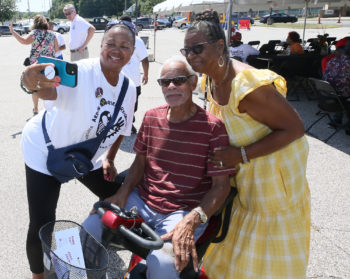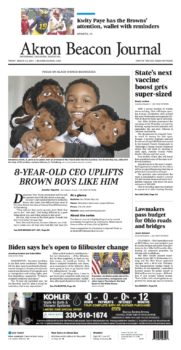How the Akron Beacon Journal has increasingly served Black readers – expanding its audience and revenue
Betty Lin-Fisher, James Mackinnon, Cheryl Powell-Fuller, Jennifer Pignolet and Michael Shearer, Akron Beacon Journal,This is a series on Better News to a) showcase innovative/experimental ideas that emerge from the Knight-Lenfest Newsroom Initiative and b) share replicable tactics that benefit the news industry as a whole. This “win” comes from a team at the Akron Beacon Journal, including Betty Lin-Fisher, consumer columnist and medical reporter; James Mackinnon, breaking news reporter; Cheryl Powell-Fuller, managing editor; Jennifer Pignolet, education reporter; and Michael Shearer, editor and North Ohio regional editor for the USA TODAY Network. The Akron Beacon Journal participated in the Major Market Table Stakes program in 2020-2021.
Question: What communities do you serve and what can you tell us about the history of your organization?
Answer: One of 21 Ohio media sites in Gannett’s USA TODAY Network, the Akron Beacon Journal primarily covers the Akron-metropolitan region of Summit County and four surrounding counties with assistance from three network newsrooms. We also cover professional sports in Cleveland and major Northeast Ohio news.
The paper traces its roots to the Summit Beacon, which was first published on April 15, 1839. By 1897, the Beacon and Republican and Evening Journal merged to stave off the failure of both. In 1937, Beacon Journal Editor and Publisher John S. Knight bought the Miami Herald in a string of purchases that would eventually become Knight-Ridder Newspapers. Through those years, the newspaper won four Pulitzer prizes and became known as one of America’s best newspapers.
A series of corporate changes since 2006 saw the newspaper change ownership three times amid a steep decline in revenue, subscriptions and staffing. Gatehouse Media acquired the Beacon Journal/Ohio.com in May 2018 and then merged with Gannett in late 2019. By then it was clear we were significantly behind in converting our eroding print audience into paid digital subscribers.
Q: What problem were you trying to solve, and why was solving the problem strategically important for your organization?
A: We needed to dramatically grow our paid online subscription base to generate revenue supporting our core journalism mission in the community. Marketing data also showed significant gaps in reaching three key audiences online, including Black readers, those aged 25-44 and households with under $60,000 income.

Judi Hill, Akron NAACP President, takes a selfie with Norris and Cheryl Hill at the Innerbelt Reunion, co-sponsored by the Akron Beacon Journal, at the Akron Urban League. (Mike Cardew/Akron Beacon Journal)
Our newsroom goal is to grow our paid digital subscription revenue to a level that sustains funding for our journalism. We also knew that if we were deficient in providing news relevant to these three groups of people in our community, we were not doing a sufficient job covering our community.
Q: How is this approach related to Table Stakes (e.g. one of the 7 Table Stakes and/or an outgrowth of the Knight-Lenfest initiative, etc.)?
A: This approach is related to Table Stake No. 1 (“Serve targeted audiences with targeted content”), Table Stake No. 2 (“Publish on the platforms used by your targeted audiences”), Table Stake No. 3 (“Produce and publish continuously to meet audience needs”) and Table Stake No. 4 (“Funnel occasional users to habitual and paying/valuable loyalists”).
Q: How did you go about solving the problem?
A: During our Table Stakes project, we identified our three target audiences. We then reached out to people in those groups through more than 60 virtual interviews (during 2020) to learn more about their interests and expectations to build three audience personas.
For Black readers, our efforts focused on identifying and generating content our diverse community wants to see and diversifying our staff to ensure we can properly serve the entire community.

Bertina King, an Akron police detective walks past the photo display on the fence during the Innerbelt Reunion. (Mike Cardew/Akron Beacon Journal)
In brainstorming for Black History Month coverage for February 2021, an editor pitched trying to profile as many Black-owned businesses as possible. The idea grew partly out of a frustration from the summer of 2020 when a competitor published a list of Black-owned businesses after the murder of George Floyd. We could not match the content at that time.
Our staff embraced the idea and produced 26 features throughout February that really resonated with all of our diverse audiences and even the Chamber of Commerce.
Since 2021, we have written 67 stories focusing on Black-owned businesses, averaging 3,300 page views each and leading to 77 digital subscriptions.
Additional content efforts included:
- a deep look at racism as a public health issue, including grants via a third party for startup initiatives
- an in-depth examination of how a failed “Innerbelt” freeway project disproportionately impacted Black families and businesses
- ensuring we featured diverse restaurants and chefs in our food coverage
- and a mobile newsroom initiative at a library in a predominantly Black area.
We’ve also robustly covered five police shootings and aggressively sought public records we believe the city of Akron is illegally withholding.
In 2020, editors also convened an advisory board of Black leaders who meet virtually with editors every two months to discuss recent events and our coverage. Their feedback proved to be valuable on more than one occasion, including a discussion of our coverage of the Cleveland Browns controversial trade for Deshaun Watson. We’ve received positive comments on the intentionality of our diversity efforts and willingness to have a dialogue on a routine basis.
On the staffing side, we’ve worked to successfully recruit two full-time diverse journalists, including an editor. We have added a Black community columnist and have begun working with freelance journalists of color in hopes of developing them into full-time journalists.
Read more about increasing revenue by reaching new audiences: National Topics | Spanish-speaking Audiences | Sports Fans
Q: What worked?
A: We believe all of the journalism described above has helped us reconnect with the Black community. But our efforts remain a work in progress and we’re far from declaring “mission accomplished.” The encouraging news is we’ve seen stronger growth of paid digital subscriptions in ZIP codes with a Black majority population (+243% year over year) and those that over-index as non-white (272%). During the same time, overall paid digital subscribers grew by 216%.
Q: What didn’t work?
A: With a company emphasis on placing our best or premium journalism behind a subscriber-only paywall, we struggled with balancing our desire to attract new audiences to the top of our sales funnel and driving immediate subscriptions.
Some staffers also resisted premium placements based on their understandable desire to serve all people. In the end, very few stories for targeted readers were made premium, although recent exclusive reporting on the police shooting case have been subscriber only. We also struggle with tagging content to assist us in tracking it.
Q: What happened that you didn’t expect?
A: The Innerbelt reporting project sparked an idea from a reader to invite people displaced by the highway to a reunion event. Co-leading planning for the event on August 28, 2022, helped us build stronger relationships with Black community leaders. And we produced another in-depth feature on people’s stories told at the event.

Michael Shearer, editor of the Akron Beacon Journal, talks to the attendees of the Innerbelt Reunion. (Mike Cardew/Akron Beacon Journal)
The event drew hundreds of people at the Akron Urban League to look at old photographs, reminisce and hear speakers discuss moving forward now that the city of Akron owns 30 acres of abandoned highway. This effort proved to be a critical asset when eight Akron police officers shot a Black man 46 times, killing him, on June 27, 2022, leading to weeks of protests, a downtown curfew and ongoing tensions. We were far better positioned to successfully cover the story than a few years earlier.
Q: What would you do differently now? What did you learn?
A: We’ve been reminded that writing quality stories about real people can pay dividends. We’ve revamped our diversity beat into a second City of Akron position covering issues and people, including the impact of City Hall decisions. This will help overcome an issue where some reporters did not view diversity issues as part of their beats and improve our coverage of Akron.
We’re also now embarking on expanding our efforts to focus on the 25-44 age group using lessons of our efforts to reach Black readers. For example, when several middle schoolers were sickened by gummies apparently laced with marijuana, we turned a quick effort on what parents should know about cannabis-infused products. We need to keep parents top of mind when considering how to cover stories.

A page from the Akron Beacon Journal that features a story about a Black-owned business
Q: What advice would you give to others who try to do this?
A: Keep it simple. Not everything has to be enterprise coverage. The simplicity of Black-owned business features really allowed us to do multiple stories that connected with all segments of our diverse community.
Q: Is there anything else you’d like to add?
A: It’s hard to get off the daily news hamster wheel, but it is worth it to take a step back and really look at what you’re covering and why. We stopped covering a lot of smaller stories that weren’t serving readers. It took a while to break habits of churning content for the sake of content, but it has made us better able to meet the needs of our readers and to produce more stories that are better read and cause people to want to pay us for our work.